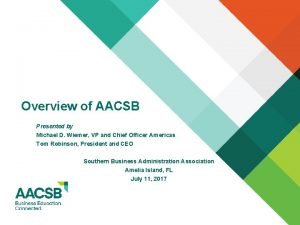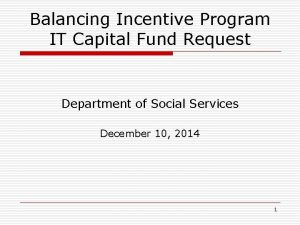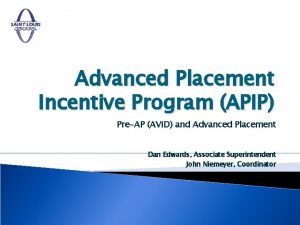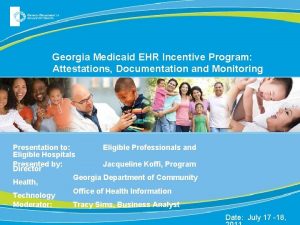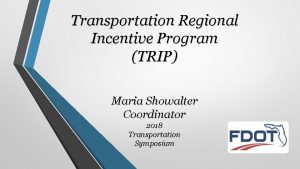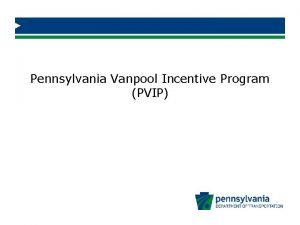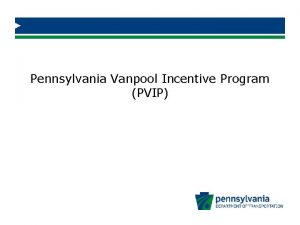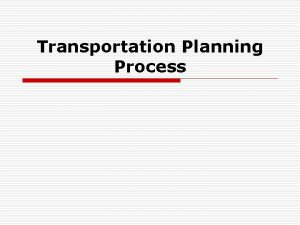Transportation Regional Incentive Program TRIP Maria Showalter Planning













- Slides: 13

Transportation Regional Incentive Program (TRIP) Maria Showalter Planning Specialist TRIP Coordinator

What is TRIP? ØThe TRIP Program provides funding to improve regionally significant transportation facilities in regional transportation areas defined by Florida Statute 339. 2819. ØThe purpose of the programing is to encourage regional planning by providing state matching funds for improvements to regionally significant transportation facilities identified and prioritized by regional partners. ØFunds are allocated to Districts as specified in Florida Statute 201. 15 to the State Transportation Trust Fund. ØThe Department shall provide a maximum of 50% of eligible cost for eligible projects also defined as a phase or combination of phases proposed for funding.

A transportation project that is on a facility which serves regional transportation needs (such as access to and from the area outside of the region, major activity centers in the region, major planned developments such as new retail malls, sports complexes, etc. , or transportation terminals) and would normally be included in the modeling of a TPO area transportation network, including at a minimum all principal arterial highways and all fixed guideway transit facilities that offer an alternative to regional highway travel. Definition of REGIONAL:

Who is eligible to participate? All MPOs, Counties, and Multi-County Transportation Authorities are eligible to participate, if they form partnerships. ØTwo or more contiguous MPOs, ØOne or more MPOs and one or more contiguous non - MPO Counties, ØMulti-county regional transportation authorities, ØTwo or more contiguous non-MPO counties, ØMPOs comprised of three or more counties.

What are the responsibilities of the Partners? Regional partners must develop an interlocal agreement that provides the following: ØIncludes development of the regional transportation plan; ØDelineates the boundaries of the regional transportation area; ØProvides the duration of the agreement and how it may be changed; ØDescribes the planning process, and defines a dispute resolution process.

Project requirements for TRIP funding ØMust support facilities that… • Serve national, statewide or regional functions ü Project must serve a regional need and the transportation facility must be noted within the RTA’s plan and map. • Function as an integrated regional system • • • Identified in Capital Improvement Element in the appropriate local government comprehensive plan; ØMust be supported by local planning efforts: Project must be in compliance with the area TPO plans, Be in compliance with local corridor management policies within the comprehensive plan. ØMust be consistent with the Strategic Intermodal System; example: adding capacity ØMust have a commitment of local, regional or private matching funds, unless eligible for a match waiver.

Project PRIORITY outline (F. S. 339 -2819) ØProvide connectivity to the Strategic Intermodal System ØSupport economic development and goods movement in rural areas of economic opportunity (RAO), ØAre subject to local ordinances that establish corridor management techniques, ØImprove connectivity between military installations and the Strategic Highway Network (STRAHNET) or the Strategic Rail Corridor Network (STRACNET), and ØThe extent to which local matching funds are available to be committed to the project.

Work Program Development Cycle Standard Cycle Accelerated Cycle JULY Final Adoption of Work Program (AD) System opens for tentative activities (G 1) APRIL-JUNE Address concerns and make final decisions Final Adoption of Work Program (AD) System opens for Tentative activities (G 1) AUGUST-OCTOBER FEBRUARY-JUNE AUGUST Assimilation of the Tentative Work Address concerns and make final decisions Assimilation of the Tentative Work Program (G 1) MARCH NOVEMBER Statewide Public Hearing Legislature Convenes System closes to balance the Tentative Work Program (G 1) JANUARY SEPTEMBER Statewide Public Hearing Legislature Convenes System closes to balance the Tentative (G 1) FEBRUARY Central Office submits Tentative to Governor’s Office & Legislature JANUARY Secretary Review by Central Office & Florida Transportation Commission Assessment DECEMBER Hold Work Program EPublic Hearing & present tentative to the TPO’s DECEMBER Central Office submits Tentative (G 1) to Governor’s Office & Legislature OCTOBER NOVEMBER Secretary Review by Central Office & Florida Transportation Commission Assessment Hold Work Program E-Public Hearing & present Tentative (G 1) to the TPO’s

FY 2022 - 2026 Development Cycle Emerald Coast Regional Council Caitlin Cerame, AICP 850 -332 -7976, ext. 203 Caitlin. cerame@ecrc. org Capital Regional Planning Council Greg Burke, AICP 850 -891 -8626 Greg. burke@talgov. com

TRIP Application

GAP (Grant Application Process) • The Implementing Agency will need to submit and upload all requested information in the GAP system.

Can a project be submitted for TRIP funds that does not originate from a Regional Transportation Plan? • No. The project must come from an approved Regional Transportation Plan. Frequently Asked Questions What does it mean for a project to be "consistent with the Strategic Intermodal System Plan"? • Being consistent with the SIS means that the project serves a national, statewide, or regional function, and it serves an integral part of an interconnected regional network. If an eligible rural county is granted a waiver or reduction for its share of the non-TRIP match of project costs, can TRIP funds be used to cover the balance? • In those instances where a match has been waived or reduced, the scope of the project will have to be reduced. Who decides what is regionally significant and what are the criteria? • Regional transportation areas designate regionally significant facilities. The definition of "regionally significant" is expected to vary according to the characteristics and policies of each region. FDOT has provided guidance for these designations and identified characteristics for consideration. This information can be found within the resources webpage.

Maria Showalter D 3 TRIP Coordinator 850 -330 -1550 Maria. Showalter@dot. state. fl. us Lorraine Moyle State Local Programs Administrator (850) 414 -4383 Lorraine. Moyle@dot. state. fl. us https: //nwflroads. com/planning https: //www. fdot. gov/programmanagement/L P/TRIP/Default. shtm
 Anthony johnson showalter
Anthony johnson showalter Yvipec
Yvipec Nhs learning support fund regional incentive
Nhs learning support fund regional incentive Billy once upon a time
Billy once upon a time Pinal regional transportation authority
Pinal regional transportation authority Baltimore regional transportation board
Baltimore regional transportation board Amway products catalogue 2013
Amway products catalogue 2013 Indian incentive program
Indian incentive program Microsoft azure channel incentive
Microsoft azure channel incentive Microsoft partner incentive program
Microsoft partner incentive program Michigan tuition incentive program
Michigan tuition incentive program Balancing incentive program
Balancing incentive program Advanced placement incentive program
Advanced placement incentive program Ny medicaid ehr incentive program
Ny medicaid ehr incentive program
